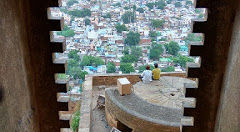“Prejudice is a burden that confuses the past, threatens the future and renders the present inaccessible.” What’s the starting point? Morality and fairness? Or Success and effectiveness?

I stepped out of a session on ‘Building inclusive classrooms through the Arts’ and much to my surprise, rather shock I see a group of people screaming, or should I say theatrically articulating using body and movement J. The noise was to convey that the land little beyond the lease land on which the school is built cannot be used for anything else as it needs to be set aside for a temple on the far end of a hill that it overlooks. The voice and language intonation and vocabulary had threats, curses, abuses , swears and more. The principal said something that most of us would echo with ‘Inka inclusion kaise karein? We can work with the children in the classes at set up model centres, but what do we do about this prejudice and mind set?’ Having been through similar situations, I could see where she was coming from and also how far we have come in the way we think about these things, in the steps we take each day.
Inclusion is about the intentional building of relationships and creating conversations. Inclusion embodies the idea that identity is something to be continually re-negotiated as successive waves of groups enter into conversation with the majority. So in this way conversation is not just an excellent metaphor for the meaning of inclusion, it is also a vital mechanism to achieve it. It is through conversation that we can respectfully negotiate the terms of a partnership, but at the same time we appreciate conversation for its own sake, are not threatened or dissatisfied by the fact that it is open-ended.
But if building an inclusive society through conversation is to be sincere and productive, it has to be done between partners who demonstrate mutual respect, and be capable of freely engaging; partners with a clear sense of others, but also of themselves. It seems to me that this sort of capacity or capability is also at the core of what we mean by “inclusion”.
An important prerequisite of this sort of freedom is having a fully developed sense of self, of capacities to define what we value, and to make the choices necessary to get us there.
I would like to put the focus on children, and suggest that if a society is inclusive, it is in the very least a society in which children can become all that they can be. Obviously this is not the only dimension, and part of the task facing us is to clarify other dimensions through our conversations and deliberate efforts. But focusing on children and educators, facilitating these conversations through creative non-threatening artistic tools allows us to illustrate a framework for understanding the underlying drivers of inclusion, of the challenges facing schools, institutions; in short societies seeking to be more inclusive.
Unless diversity is welcomed, and relationships are consciously nurtured, there will be little change in the educational experience for children. Of course, policy and legislative change is desirable, specialist skills can be useful and a greater financial investment in schools would be excellent, but making the correct choices that are effective is critical.
As I look back at what happened at the school I feel ‘Social Cohesion’ that brings and hold people together in society is what we need to aspire for. A society in which all individuals and groups have a sense of belonging, participation, inclusion, recognition and legitimacy. By respecting diversity, we harness the potential residing in societal diversity and are less prone to slip into destructive patterns of tension and conflict when different interests meet and collide. Then creating an environment where everybody can fulfillJ.
their potential, regardless of ability, shouldn’t be difficult. Let’s start from the very beginning
Source: SnehadharaBlog

